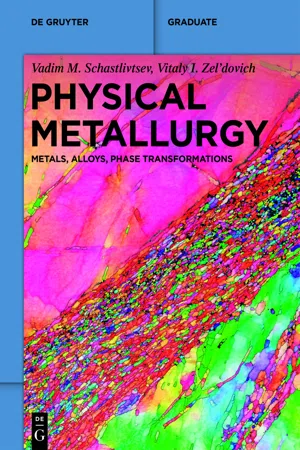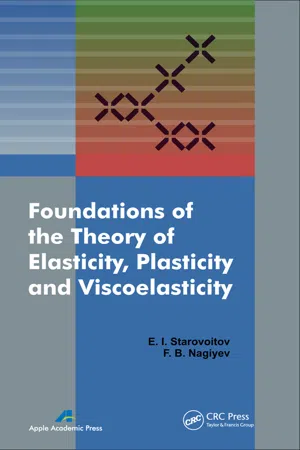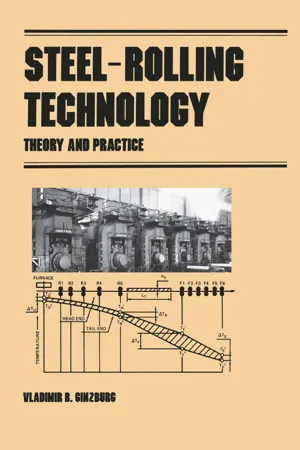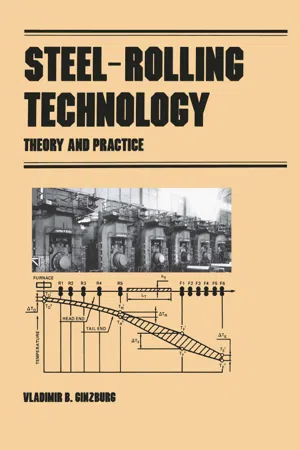Technology & Engineering
Plastic Deformation
Plastic deformation refers to the permanent change in shape of a material when subjected to an applied force. This process occurs when the material is stressed beyond its elastic limit, causing it to undergo a non-reversible change in shape. Plastic deformation is a key concept in materials science and engineering, influencing the design and behavior of various structures and components.
Written by Perlego with AI-assistance
Related key terms
1 of 5
10 Key excerpts on "Plastic Deformation"
- eBook - ePub
Physical Metallurgy
Metals, Alloys, Phase Transformations
- Vadim M. Schastlivtsev, Vitaly I. Zel'dovich(Authors)
- 2022(Publication Date)
- De Gruyter(Publisher)
Chapter 5 Plastic Deformation and recrystallization5.1 Elastic and Plastic Deformation: definitions
Deformation is any change in the shape and size of a body as a result of mechanical action. If deformation disappears after mechanical stresses stop acting, this is elastic deformation. It obeys Hooke’s law. Hooke’s law under tension has the formσ = E ε ,where σ is the normal stress, E is the modulus of normal elasticity, and ε is the relative deformation (elongation). Hooke’s law in shear is given byτ = G γ ,where τ is the shear stress, G is the shear modulus, and γ is the shear angle.If deformation and its consequences persist after the action of stresses, this is Plastic Deformation. For metallic materials, Plastic Deformation is usually accompanied by strain hardening or work hardening. The latter is due to irreversible changes in the crystal structure. In this case, lattice defects arise, mainly dislocations, as well as vacancies and interstitial atoms. It should be noted that the work hardening can be created by such Plastic Deformation that does not change the shape and size of a body. Examples include deformation under the action of shock waves or equal channel angular pressing. Therefore, a more general definition of deformation in mechanics is a change in the relative position of points of a body as a result of mechanical action. The simplest types of deformation are stretching, compression, shear, bending, and torsion.The value (degree) of Plastic Deformation under tension can be calculated by the formula:ε =L −/L 0L 0,where ε is the relative deformation, L0 is the length of a sample before stretching, and L is the length of the sample after stretching. This expression is valid ifε < < 1.For any values of the degree of deformation, the formula appears as follows:ε =l nL /.L 0Plastic Deformation is said to be cold, warm, or hot, depending on the deformation temperature. The borderline between these types of deformation is not clearly defined, and it depends on the mobility of the dislocations. - eBook - PDF
- Eliahu Zahavi, David M. Barlam(Authors)
- 2000(Publication Date)
- CRC Press(Publisher)
107 4 Plasticity Plastic Deformation is an irreversible process characterized by sustained changes in the original geometry. Consider monotonic loading of a body made of ductile metal. The body undergoes deformation that is proportional to the magnitude of the applied load. Up to a certain magnitude, the deformation is elastic and is reversible (see Chapter 1). After a critical point, parts of the body are subjected to plastic defor-mation, leaving a permanent distortion. In the following, we present the fundamentals of the theory of plasticity. We start with one-dimensional empirical correlations and extend the description to include the basics of the three-dimensional plasticity theory. 1,2,3 4.1 ONE-DIMENSIONAL THEORY 4.1.1 S TRESS -STRAIN RELATIONSHIP Tensional Test Tensional tests are performed on standard specimen to derive basic mechanical properties of materials. The deformation is measured as function of the applied load during axial tension of the specimen (see Figure 4.1). The standard data comprise diagrams of stresses versus strains. A typical stress-strain diagram from a specimen made of low-carbon or mid-carbon steel is shown in the Figure 4.2a. One can observe the following features on this curve. At the start, until point A is reached, there is a linear relation between the stress and strain, which follows the Hooke’s law. At point A , the stress slightly drops, up to point . From here to point B, the stress is practically constant, with small oscillations. Point indicates a stress at which the specimen undergoes a marked elongation without an increase in load. This point is called yield strength or yield point and is designated as S yp . A rising curve up to point C indicates material’s hardening with an increase of the load. This point is called ultimate strength and is designated as S u . Beyond this point, the curve drops, ending abruptly, which indicates material’s final failure. - eBook - PDF
Preferred Orientation in Deformed Metal and Rocks
An introduction to Modern Texture Analysis
- Hans Rudolf Wenk(Author)
- 2013(Publication Date)
- Academic Press(Publisher)
10 Regimes of Plastic Deformation T. G. LANGDON Departments of Materials Science, Mechanical Engineering and Geological Sciences University of Southern California Los Angeles, California 1. Introduction When crystalline materials are deformed at a constant rate of strain, the initial elastic behavior gives way to plastic yielding at a well-defined yield stress: details of the shape of the associated stress-strain curve are given in Chapter 2. There are several different processes of crystalline plasticity, and an important requirement in deformation studies is therefore to understand, and preferably to be able to predict, the precise process occurring under any selected conditions. In order to achieve this goal, the usual method is to examine and tabulate the characteristics of the various deformation processes, to develop constitutive relations that describe the rates of flow in terms of external parameters, and then to use these relations to construct pictorial representations in the form of deformation mechanism maps to delineate the precise set of conditions where each individual mechanism is dominant. 2. The Mechanisms of Plastic Deformation It is a convenient procedure to divide the various mechanisms of plastic deforma-tion into two distinct groups: lattice mechanisms are those processes occurring within the crystalline lattice and which are not associated with the presence of grain bounda-ries whereas boundary mechanisms are modes of deformation associated with the boundaries (Langdon, 1975). This distinction has the advantage of distinguishing between the behavior of single crystals where boundary mechanisms do not occur and the behavior of polycrystalline aggregates where both types of mechanism gener-ally contribute to the total deformation. The nature of the various mechanisms is now considered for conditions where materials flow plastically without fracture. PREFERRED ORIENTATION IN 219 Copyright © 1985 by Academic Press, Inc. - Eduard Starovoitov, Faig Bakhman Ogli Naghiyev(Authors)
- 2012(Publication Date)
- Apple Academic Press(Publisher)
Chapter 8 Foundations of the Theory of Plasticity Deformability of solids under the effect of external forces and their capability of per-ceiving constant or residual ( plastic ) strains at unloading is called plasticity . There is, however, no unequivocal dependence between stresses and strains arising in the body, which means that it is impossible to find strains in terms of stresses, and vice versa, one cannot determine stresses proceeding from known strains. The theory of plasticity deals with the laws interrelating stresses with elastoPlastic Deformations and the development of problem-solving methods on equilibrium and motion of deformed solid bodies. The theory of plasticity, forms the basis of today’s calculations of different structures, forging processes, rolling, punching, and so forth, as well as natural processes (e.g., orogenesis). This allows to reveal strength and de-formation potential of materials. Plastic Deformation till fracture may reach 10–20%, while elastic deformations––only 0.3–0.5%. That is why strength calculations based on the assumption of only elastic deformations are often inexpedient both technically and economically. By taking Plastic Deformations into account, we may reduce stress concentration in structures, increase resistance of bodies to impact loads, de fi ne safety margins, rigidity and stability, ensuring thereby most ef fi cient functioning, reliability and safety of structures. PLASTICITY OF MATERIALS AT TENSION AND COMPRESSION The phenomena of elasticity and plasticity are displayed at sufficiently slow so-called static or quasi-static application of external forces. In this case, the phenomenon of deformability does not in fact depend on time, loading rate, and duration of external forces. Let us consider the basic phenomena of plasticity by a simplest example of tension and compression of a cylindrical sample.- eBook - ePub
Steel-Rolling Technology
Theory and Practice
- Vladimir B. Ginzburg(Author)
- 1989(Publication Date)
- CRC Press(Publisher)
Part IV Theory of Plastic DeformationPassage contains an image
12 Principles of Mioroscopic Plasticity
12.1 Elastic And Plastic Deformation
The microscopic viewpoint deals with a physical explanation of plasticity and establishes relationship between plastic behavior and the interatomic forces acting within the crystal structure of a metal.Elastic deformation is usually defined as a change in dimensions directly proportional to and in phase with an increase or decrease in applied force [1 ]. In elastic deformation a limited distortion of the crystal lattice occurs, and as soon as the force is removed, the distortion disappears (Fig. 12.1 ).Plastic Deformation is commonly defined as a change in dimensions that does or will remain permanent after removal of the load that caused it. In Plastic Deformation an extensive rearrangement of atoms within the lattice structure takes place resulting in this permanent distortion.Before stressingFig. 12.1 Diagrams illustrating the difference, in action and effect, of deformation by elastic and plastic means. (From ENGINEERING PLASTICITY, Part 1, by R.A. Higgins, 1983 . Copyright Hodder & Stoughton Ltd., England. Reprinted with permission).12.2 Deformation By Slip
Plastic Deformation proceed in metals by a process known as 'slip'. This is an irreversible shear displacement of one part of a crystal relative to another in a definite crystallographic direction in which the translation of slip takes place [1 , 2 ].Slip occurs in directions in which atoms are most closely packed since this requires the least amount of energy. In a face-centered cubic lattice (Fig. 12.2 ) the (111) plane of densest atomic population intersects the (001) plane in line ac. When the (001) plane is assumed to be the plane of the paper (Fig. 12.3 ), slip is seen as a movement along the (111) plane in the close-packed [110] direction [3 , 4 ].The result of slip in a polycrystalline mass of metal may be observed by a microscopical examination and is known as 'slip bands'.Fig. 12.2 - eBook - PDF
- T. W. Clyne, J. E. Campbell(Authors)
- 2021(Publication Date)
- Cambridge University Press(Publisher)
4 Mechanisms of Plastic Deformation in Metals The capacity of metals to undergo large plastic strains (without fracturing) is one of their most important characteristics. It allows them to be formed into complex shapes. It also means that a component under mechanical load is likely to experience some (local) plasticity, rather than starting to crack or exhibit other kinds of damage that could impair its function. Metals are in general superior to other types of material in this respect. This has been known for millennia, but the reasons behind it, and the mechanisms involved in metal plasticity, only started to become clear less than a century ago and have been understood in real depth for just a few decades. Central to this understanding is the atomic scale structure of dislocations, and the ways in which they can move so as to cause Plastic Deformation, although there are also several other plasticity mechanisms that can be activated under certain circumstances. These are described in this chapter, together with information about how they tend to be affected by the metal microstructure. This term encompasses a complex range of features, including crystal structure, grain size, texture, alloying additions, impurities, phase constitution etc. 4.1 Basic Dislocation Structures and Motions 4.1.1 The Atomic Scale Structure of Metals Dislocations can exist in various types of (crystalline) material, but they tend to be both more numerous and more mobile in metals, compared with, say, ceramics, intermetallics or organic materials. The underlying reason for this is related to the types of interatomic bonding in different materials. In non-metallic materials such as ceramics, there are strong directional bonds between neighboring atoms, usually either ionic (adjacent atoms carrying charge of opposite sign) or covalent (electrons local- ized in orbitals shared between neighboring atoms), or possibly there is an element of both types. - eBook - PDF
Rheology V1
Theory and Applications
- Frederick Eirich(Author)
- 2012(Publication Date)
- Academic Press(Publisher)
The mathematical analysis of permanent deformations is greatly sim-plified when the two types of flow are considered separately. Except for a brief section on visco-plastic flow (section IV), this article is con-cerned with plastic flow only. 2. PLASTIC-RIGID SOLIDS The yield limit of a plastic material indicates the stress level below which Plastic Deformation is absent or insignificant. Some materials (for instance, mild steel) possess a sharply defined natural yield limit. For most materials, however, the yield limit is conventional: plastic deforma-tions are ignored until they exceed a critical magnitude that depends on the problem under consideration. Technological problems concerning stresses and strains in plastic solids fall into two groups, which may be labeled problems of small elastic-Plastic Deformations and problems of plastic flow . In problems of the first kind, the deformations of the plastic portions of the solid are restricted by the fact that adjacent portions of the solid have not yet reached the yield limit and hence are capable of small elastic deformations only. The presence of elasti-cally stressed portions of the solid is not excluded in problems of the second kind, but the geometry of these portions is assumed to be such that they cannot prevent large deformations of the plastic portions. In a grooved ten-sion specimen, for instance, Plastic Deformation begins at the groove, but the extension of the specimen is controlled by the elastic core until the plastic portion extends all the way across the specimen. Different mathematical simplifications are appropriate in each case. In problems of small elastic-Plastic Deformations, the strains may be treated as infinitesimal, but both elastic and plastic strains must be considered, be-cause they are of the same order of magnitude. - eBook - PDF
Steel-Rolling Technology
Theory and Practice
- Ginzburg(Author)
- 1989(Publication Date)
- CRC Press(Publisher)
Part IV Theory of Plastic Deformation 12 Principles of Microscopic Plasticity 1 2 . 1 E L A S T I C A N D P L A S T I C D E F O R M A T I O N T h e m i c r o s c o p i c v i e w p o i n t d e a l s w i t h a p h y s i c a l e x p l a n a t i o n o f p l a s t i c i t y a n d e s t a b l i s h e s r e l a t i o n s h i p b e t w e e n p l a s t i c b e h a v i o r a n d t h e i n t e r a t o m i c f o r c e s a c t i n g w i t h i n t h e c r y s t a l s t r u c t u r e o f a m e t a l . E l a s t i c d e f o r m a t i o n i s u s u a l l y d e f i n e d a s a c h a n g e i n d i m e n s i o n s d i r e c t l y p r o p o r t i o n a l t o a n d i n p h a s e w i t h a n i n c r e a s e o r d e c r e a s e i n a p p l i e d f o r c e [ 1 ] . I n e l a s t i c d e f o r m a t i o n a l i m i t e d d i s t o r t i o n o f t h e c r y s t a l l a t t i c e o c c u r s , a n d a s s o o n a s t h e f o r c e i s r e m o v e d , t h e d i s t o r t i o n d i s a p p e a r s ( F i g . 1 2 . 1 ) . P l a s t i c d e f o r m a t i o n i s c o m m o n l y d e f i n e d a s a c h a n g e i n d i m e n s i o n s t h a t d o e s o r w i l l r e m a i n p e r m a n e n t a f t e r r e m o v a l o f t h e l o a d t h a t c a u s e d i t . I n p l a s t i c d e f o r m a t i o n a n e x t e n s i v e r e a r r a n g e m e n t o f a t o m s w i t h i n t h e l a t t i c e s t r u c t u r e t a k e s p l a c e r e s u l t i n g i n t h i s p e r m a n e n t d i s t o r t i o n . Before stressing D Stress removed D Elastic deformation on Iy Stress removed Stress acting ---. , . . / - . J 1 / 7 / I I I Before stressing D Elastic and Plastic Deformation F i g . 1 2 . 1 D i a g r a m s i l l u s t r a t i n g t h e d i f f e r e n c e , in a c t i o n and e f f e c t , o f d e f o n n a t i o n b y e l a s t i c a n d p l a s t i c m e a n s . - eBook - PDF
Continuum Mechanics
Elasticity, Plasticity, Viscoelasticity
- Ellis H. Dill(Author)
- 2006(Publication Date)
- CRC Press(Publisher)
159 4 Plasticity 4.1 CLASSICAL THEORY OF PLASTICITY We review here the classical theory of plasticity for small displacements, a theory that describes the relation between load and deformation for many metals at higher stresses. Temperature changes will not be considered in this section. The constitutive relations are rate-independent. Time is used to keep track of events but the relations are independent of the time scale. Whenever components are introduced, a normal basis is implied. In very qualitative terms, if one performs a tensile test on metals (Fig. 4.1.1) by applying a uniaxial stress τ 11 = σ ( t ), apparent elastic behavior occurs until a limiting stress σ = Y , called the yield stress, is exceeded. After loading beyond the initial yield stress to σ = σ b , unloading to zero stress leaves a residual strain ε 11 = ε P called the plastic strain. The response to subsequent loading is incrementally elastic as long as the previous maximum stress is not exceeded, σ – σ b < 0, but yielding again occurs at σ – σ b = 0. Furthermore, the measured stress and strain are independent of the rate of loading. For any stress, ε = ε P + ε e = ε P + σ /E. If the equation of the curve a – b is ε = f ( σ ), then ε P = f ( σ ) – σ / E . So, ε P is a function of σ , or inversely σ = H ( ε P ). For plastic loading from a to b , , where is the plastic modulus. In summary, there is a yield criterion , and the material is incremen-tally elastic ( and ) if or if and . Incre-mental plastic strain ( ) occurs if and . During plastic loading, σ max increases so that we always have the yield criterion σ – σ max = 0. FIGURE 4.1.1 Tensile test for elastic-plastic material. σ ε = > E P P 0 E H dH d P P = ′ = / ε σ σ − ≤ max 0 ε P = 0 σ ε = E σ σ − < max 0 σ σ − = max 0 σ < 0 ε σ P P = / E σ σ − = max 0 σ > 0 o a b E E Y 1 1 ε (t) σ (t) 1 E T ε p Elastic regime Plastic loading Initial yield stress Initial elastic regime Plastic strain Elastic strain ε e σ max Reload yield - eBook - PDF
- Marc André Meyers, Krishan Kumar Chawla(Authors)
- 2008(Publication Date)
- Cambridge University Press(Publisher)
An actual example is shown in Figure 3.17. The 0.2% proof stress (the stress at which 0.2% plastic strain occurs) in compression is divided by the tensile flow stress that preceded it. These values are 188 PLASTICITY 2 1 0 IR 2R E s t s 2 s c s 4 s 3 s Fig. 3.16 The Bauschinger effect. 1010 Steels: 0 1 1.0 0.8 0.6 0.4 0.2 2 3 4 5 Prestrain, × 10 − 2 σ c / σ t 1045 20 MnMoNi55 1080 Fig. 3.17 Ratio of compressive flow stress (0.2% plastic strain) and tensile flow stress at different levels of plastic strain for different steels. (After B. Scholtes, O. V¨ ohringer, and E. Macherauch, Proc. ICMA6 , Vol. 1 (New York: Pergamon, 1982), p. 255.) marked in the figure, which shows three plain carbon steels and one alloy steel. The change in flow stress is indeed highly significant and increases with plastic strain in tension. Thus, this factor cannot be ignored in design considerations when a component is to be subjected to compression stresses in service after being plastically deformed in tension. 3.5 Plastic Deformation of Polymers 3.5.1 Stress–Strain Curves At a microscopic level, deformation in polymers involves stretching and rotating of molecular bonds. More commonly, one distinguishes the deformation mechanisms in polymers as brittle, ductile (with or without necking), and elastomeric. Figure 3.18 shows schematically the curves that correspond to these mechanisms. Clearly, factors such as the strain rate and temperature affect the shape of stress--strain 3.5 Plastic Deformation OF POLYMERS 189 Ductile (Necking) Elastomeric (Rubbery) Strain Stress Brittle Ductile Fig. 3.18 Schematic of the different types of stress–strain curves in a polymer. Strain Increasing strain rate or Decreasing temperature Stress Fig. 3.19 Effect of strain rate and temperature on stress–strain curves. curves, much more so in polymers than in ceramics or metals. This is because the polymers are viscoelastic; that is, their stress--strain behavior is dependent on time.
Index pages curate the most relevant extracts from our library of academic textbooks. They’ve been created using an in-house natural language model (NLM), each adding context and meaning to key research topics.









